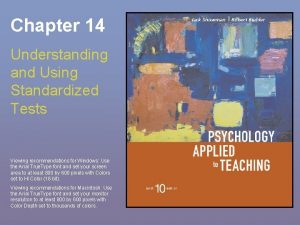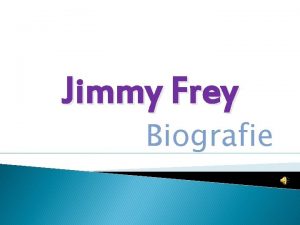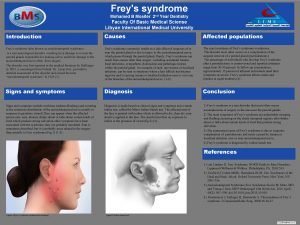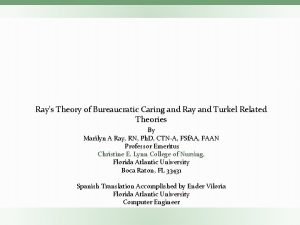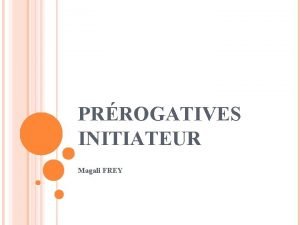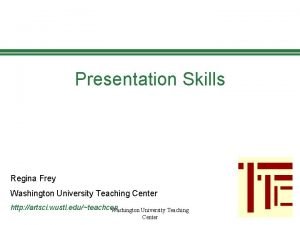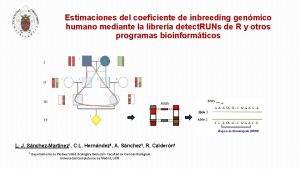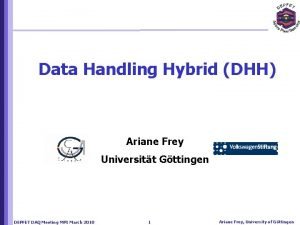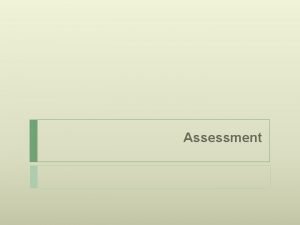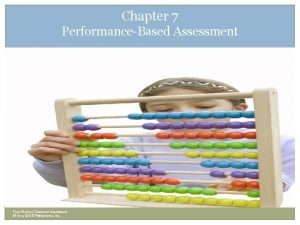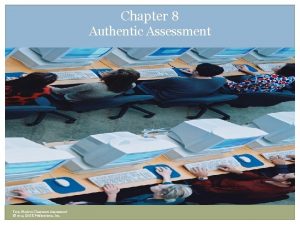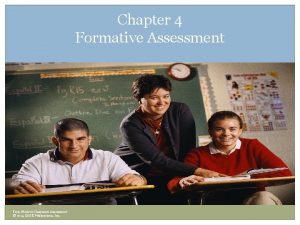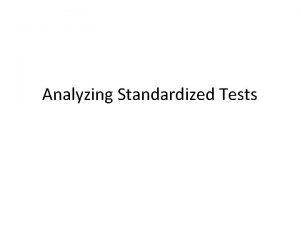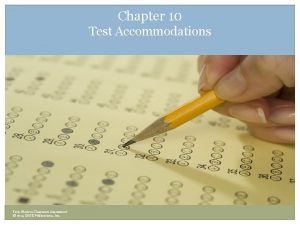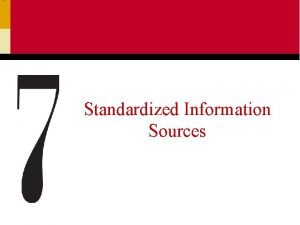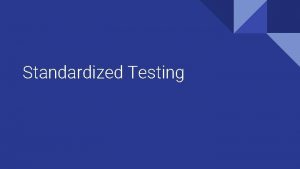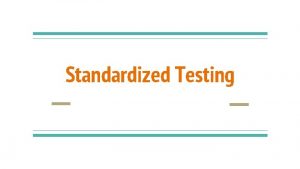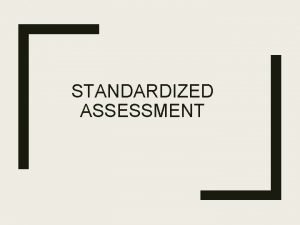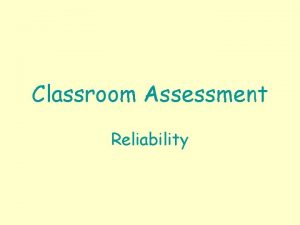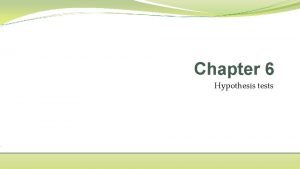Chapter 13 Standardized Tests Frey Modern Classroom Assessment

















- Slides: 17

Chapter 13 Standardized Tests Frey, Modern Classroom Assessment © 2014 SAGE Publications, Inc.

Objectives The learner will be able to: • Define standardized tests. • Describe the steps involved in creating standardized tests. • List the validity and reliability issues for standardized tests. • Interpret Z scores, T scores, percentile ranks, stanines, and other common standardized scores. • Provide examples of real-life state-wide standardized tests. • Evaluate the ethics of “teaching to the test” and other test preparation issues. Frey, Modern Classroom Assessment © 2014 SAGE Publications, Inc.

What is a Standardized Test? Two characteristics of a standardized test: Administered in a standardized way The scores it produces are standardized. Frey, Modern Classroom Assessment © 2014 SAGE Publications, Inc.

Steps in Producing a Standardized Test: 1. Identify the purpose of the assessment. 2. 3. 4. 5. 6. Define the domain or content area that the items on the test should represent. Specify the structural and technical aspects of the test. Write items. Field test and analyze the items. Construct a test (or multiple forms of the "same" test). Frey, Modern Classroom Assessment © 2014 SAGE Publications, Inc.

Validity and Reliability of Standardized Tests Three approaches for determining validity: For achievement tests - the extent to which there is a close match between the items on a test and a reasonable table of specifications supports claims for content validity Tests measuring abstract constructs or student traits - validity is a matter of whether one agrees with the test developers' definition of the construct and interpretation of research studies which examine the underlying measurement effectiveness of these tests Aptitude tests - the relevant validity argument is clear; criterion validity is most compelling Frey, Modern Classroom Assessment © 2014 SAGE Publications, Inc.

Validity and Reliability of Standardized Tests Standardized tests are usually very long. Long tests are almost always very reliable in terms of internal reliability. When some part of a test is scored and interpreted, this is another reliability concern; reliability estimates for the long test do not transfer to the shorter test Frey, Modern Classroom Assessment © 2014 SAGE Publications, Inc.

Interpreting Standardized Test Scores Z scores T scores Percentile Ranks Stanines Frey, Modern Classroom Assessment © 2014 SAGE Publications, Inc.

Z Scores The simplest standardized score Z scores are raw scores that have been transformed so that the distribution is such that the mean score is 0 and the standard deviation is 1. Example: a z score of 1. 26 means the student performed about 1 and 1/4 standard deviations above the mean. Frey, Modern Classroom Assessment © 2014 SAGE Publications, Inc.

Frey, Modern Classroom Assessment © 2014 SAGE Publications, Inc.

T Scores The highest scoring student gets scores like 1 and 2 with a Z score. Parents, students and most teachers are not used to such odd scores. T scores have a mean of 50 and a standard deviation of 10, so scores tend to range from 20 to 80. Frey, Modern Classroom Assessment © 2014 SAGE Publications, Inc.

Percentile Ranks Most commonly reported standardized score and most familiar Example: A student scores at the 70 th percentile. Meaning: This student scored higher than 70% of all other students taking the same test. Frey, Modern Classroom Assessment © 2014 SAGE Publications, Inc.

Frey, Modern Classroom Assessment © 2014 SAGE Publications, Inc.

Stanines The normal curve equally divided into 9 parts Stanines 1 -3 are below average. Stanines 4 -6 are average. Stanines 7 -9 are above average. Frey, Modern Classroom Assessment © 2014 SAGE Publications, Inc.

Frey, Modern Classroom Assessment © 2014 SAGE Publications, Inc.

Ethics of Preparing Students for Standardized Tests Teaching to the test can mean: Providing practice and specific answers to actual test questions that will be on the test Providing practice and specific answers to questions that are similar in format and content to actual test questions Providing training in general strategies for doing well on standardized tests Teaching to meet the instructional objectives that are assessed on the test Frey, Modern Classroom Assessment © 2014 SAGE Publications, Inc.

Things to Think About Which form of assessment provides more information about students, standardized tests or teacher-made classroom assessment? 2. How do the various types of standardized scores differ from each other in terms of the information they provide? 3. Most states are moving toward sharing “common core” standards and objectives. Should there be common educational standards nationwide? 4. More and more often, teachers’ jobs can depend on their students’ scores from standardized tests. Should this be the case? 1. Frey, Modern Classroom Assessment © 2014 SAGE Publications, Inc.

Key Points • • • The majority of classroom assessments in the modern classroom are teacher-designed. It is the standardized test, however, that gets all the attention. Standardized tests usually provide norm-referenced scores. These standardized scores transform raw scores into a score with a known mean and standard deviation. This way, one can easily tell whether the performance of a student is above or below the mean and how far away from the mean it is. This chapter presented Z scores, T scores, percentile ranks, stanines and a variety of other common seen standardized scores. While most standardized tests produce scores which are norm-referenced, many state tests produced criterion-referenced scores. These state-wide tests are typically used under the requirements of 2001 No Child Left Behind federal legislation to place students into categories of proficiency. There are ethical ways to prepare students for success on these tests. Frey, Modern Classroom Assessment © 2014 SAGE Publications, Inc.
 Standardized test characteristics
Standardized test characteristics Ace different tests iq tests but
Ace different tests iq tests but Designing classroom language test
Designing classroom language test Sourima mal
Sourima mal Tom waes viajes
Tom waes viajes Leeftijd jimmy frey
Leeftijd jimmy frey Frey syndrome symptoms
Frey syndrome symptoms Sibylle frey
Sibylle frey Klaus dieter frey
Klaus dieter frey Frey’s syndrome
Frey’s syndrome Marilyn anne ray theory
Marilyn anne ray theory Magalie frey
Magalie frey Regina frey
Regina frey Cullen and frey graph
Cullen and frey graph Ariane frey
Ariane frey Iris frey attac
Iris frey attac Oliver kohl-frey
Oliver kohl-frey Frey gebäudereinigung
Frey gebäudereinigung
